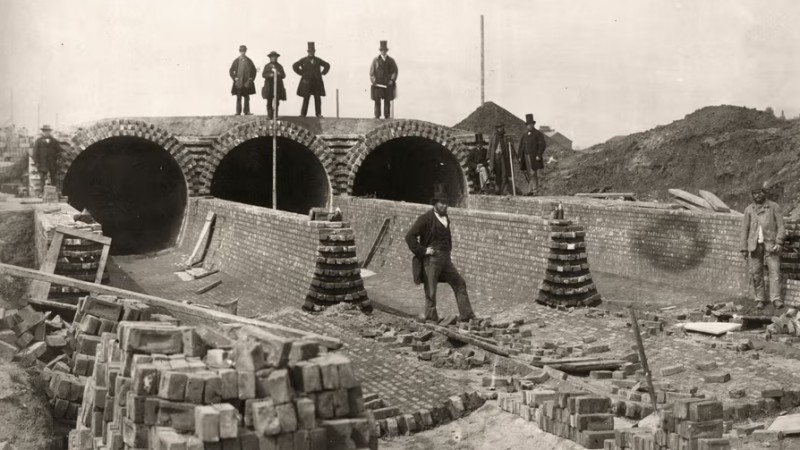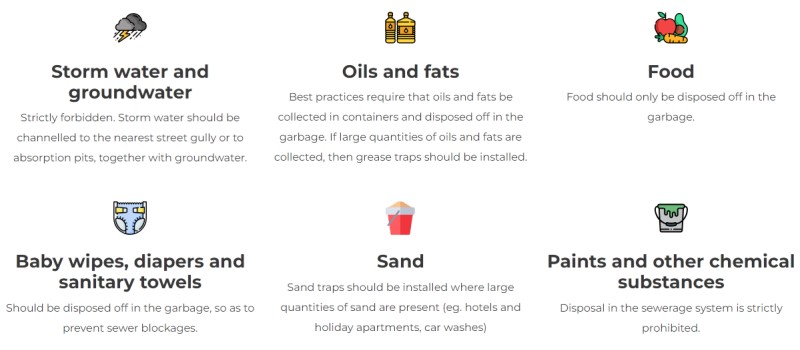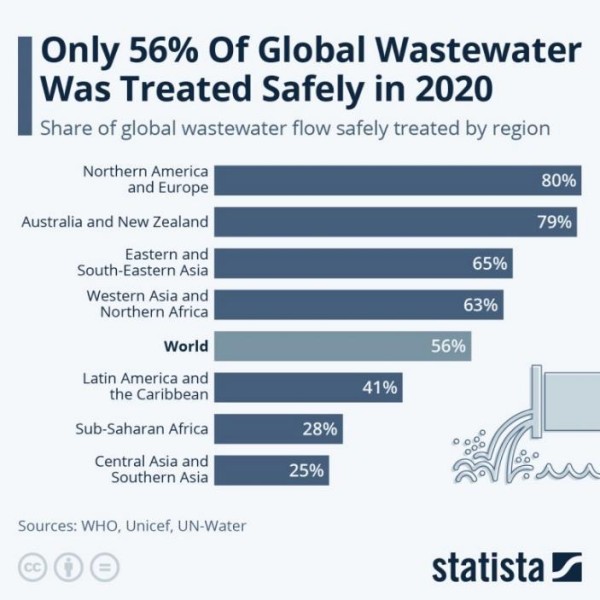Sewage Systems and Smart Cities
Modernising sewage systems in cities is important to allow cities to adapt to the effects of increasing populations and climate change. Old-fashioned sewage systems often have problems when there’s really heavy rain or when it’s really dry for a long time. This can cause sewage to overflow, which leads to flooding and dirty water getting into rivers, lakes or even our homes.
Modern and “smart” sewage systems can help with these problems. These systems use sensors, real-time monitoring, and special technology that can predict when things might go wrong. These tools can keep track of how much water is flowing, find leaks or blockages, and react quickly when there are big storms or droughts.
These changes are also important for reaching the United Nations Sustainable Development Goals (SDGs). Specifically, SDG 6 (Clean Water and Sanitation) and SDG 11 (Sustainable Cities and Communities). These goals aim to make sure everyone has clean water and lives in safe, well-managed cities. These improvements also help with the Paris Agreement on climate by making cities better at handling problems caused by climate change. So, investing in smart sewage systems isn’t just about fixing problems; it’s also about building cities that are ready for the future and help protect the planet.
What types of sewage systems exist?
In the 19th and early 20th centuries, when most of the current sewer systems in cities were built, they relied on combined sewer systems. In these systems, both wastewater (stuff from toilets, sinks, and industry) and stormwater (from rain and surface runoff) were carried through the same single pipe network. Back then, this was a convenient and cost-effective solution as you only needed one set of underground pipes (look at the first column of the figure below). But, there’s a big problem with combined systems: when there’s really heavy rain, way too much water gets into the pipes. This leads to combined sewer overflows (CSOs), where raw sewage gets dumped straight into rivers, lakes, or the ocean. This is really bad for people’s health and the environment! These overflows can cause nasty algae blooms that close beaches and parks, harm fish and other animals, make the water lose oxygen, and make people sick1Lou Farrell, “The Good, the Bad and the Green of Separate Sewer Systems.” Revolutionised. 2024. https://revolutionized.com/separate-sewer-systems/.
Climate change is causing more intense weather, which means cities are dealing with heavier rain and longer dry periods. This makes the problems with old combined sewer systems even worse. This explains why most city planners today prefer separate sewer systems. These systems use two different sets of pipes: one for sanitary wastewater and one for stormwater. This way, sewage goes to treatment plants to get cleaned up, while stormwater is handled through other ways, like drainage systems or things like green roofs and rain gardens. The main good thing about separate systems is that they stop sewage from mixing with stormwater, which means a lower chance of overflows and water pollution during big storms. As cities grow and the climate changes, separate sewer systems are seen as a more sustainable and resilient solution, which is better for the environment and public health 2Admin of RWB Group ”How Has The Sewage System Changed Since It Was Originally Designed?”. September 5, 2022. https://www.rwbgroup.co.uk/how-has-the-sewage-system-changed-since-it-was-originally-designed/ 3Lou Farrell, 2024.
However, while separate sewer systems are better for the environment, they aren’t always easy to put in place. Changing from combined sewer systems to separate ones can be super expensive, and it often means completely changing how land is used in a city. This is especially tough in densely populated areas where there’s already not a lot of space, and can cause problems for communities and even lead to legal battles4Lou Farrell, 2024.
As you can see in the figure below, with combined sewer systems, the wastewater usually goes to treatment plants to be cleaned before it’s released into rivers or lakes. But when it rains a lot, the extra water can cause overflows that pollute these water bodies.
 FIG. 1: Comparison of separated and combined sewers
FIG. 1: Comparison of separated and combined sewers
An alternative solution used in many cities is to temporarily hold stormwater in large underground tanks or reservoirs when it rains a lot. Once the storm is over and the sewer system has space again, the stored water is slowly released back into the system to be treated. While this doesn’t completely separate sewage and stormwater like the newer separate sewer systems, it helps to reduce the chance of overflows in older combined sewer networks. It’s often easier and cheaper to add these storage tanks to old systems than to rip them out and replace everything. This makes it a good compromise for cities that need to deal with more rain without building completely new systems.
What does digitalisation of sewers mean?
Digitally controlled sewer systems use advanced technology like IoT sensors (Internet of Things sensors), automation, and data analytics to control how water moves through the system better and react super quickly to changes. Smart sensors keep track of how much water is flowing, how clean it is, and the levels in the pipes, while automated valves and pumps can change things automatically to stop overflows or send water a different way during storms. Digital twins, which are like virtual copies of the real system, let engineers test out different situations and make the system work its best. And then, AI and predictive analytics help guess when there might be blockages, broken equipment, or really busy times for the system. All of this working together lets people fix things before they break, saves money on running the system, and makes sure our wastewater systems are stronger and can handle things like climate change better.
What is the history of the sewage system?
Sewage systems have been used for a really long time! The very first sewer system we know about was in a city called Mohenjo-daro way back around 2500 BC. Those early systems were built with bricks, and their main job was to take wastewater away and dump it into the rivers5Express Wastewater, “History of Sewage Treatment”. No date. https://www.expresswastewater.com.au/sewage-systems/information/history-of-sewage-treatment.
The “Great Stink” of 1858 in London was a turning point in urban sanitation history. That summer, it was super hot, and the River Thames, which was used like a giant open sewer back then, started to smell absolutely terrible, worsened by untreated human waste and industrial runoff. The awful smell was so bad it even disrupted Parliament and made people really worried about getting sick, especially with diseases like cholera spreading like they had done on previous occasions. In response, a civil engineer named Joseph Bazalgette was hired to create a big modern sewer system. He designed over 1,100 miles of underground pipes! When it was finished in the 1870s, this amazing infrastructure greatly improved public health, and it’s still the main part of London’s wastewater system today.
 FIG. 2: Construction of the London sewer system in 18706Otto Herschan/Getty, “London’s Great Stink heralds a wonder of the industrial world”. April 4, 2016. https://www.theguardian.com/cities/2016/apr/04/story-cities-14-london-great-stink-river-thames-joseph-bazalgette-sewage-system
FIG. 2: Construction of the London sewer system in 18706Otto Herschan/Getty, “London’s Great Stink heralds a wonder of the industrial world”. April 4, 2016. https://www.theguardian.com/cities/2016/apr/04/story-cities-14-london-great-stink-river-thames-joseph-bazalgette-sewage-system
Watch this video to learn more about the history of the toilet: www.youtube.com/watch?v=0dYk99S98Jc
Watch this video to learn more about how the water you flush can become the water you drink: www.youtube.com/watch?v=SYia4zqcE4g
What public health benefits do well-functioning sewers bring?
Modern sewage systems play a vital role in ensuring public health through effective wastewater removal and protection of the natural environment. With new technologies, we can clean wastewater really well and lessen the bad impact on ecosystems. Here are some of the big benefits of modern sewage systems:
- Improved water quality: An effective sewage treatment plant eliminates chemical and bacterial contamination, contributing to safer drinking water for residents.
- Protection of public health: The elimination of harmful substances from waste minimises the risk of infectious diseases and toxic effects on living organisms.
- Prevention of waterborne diseases: Improving sewage infrastructure reduces the risk of transmitting diseases such as cholera and or diarrhoea7Adebayo Olatunbosun Sojobi and Tarek Zayed. “Impact of sewer overflow on public health: A comprehensive scientometric analysis and systematic review”. January 2022. Volume 203 of Environmental Research. https://www.sciencedirect.com/science/article/abs/pii/S0013935121009038.
What can be flushed into the sewer and what should not?
Keeping the sewer system working well depends a lot on what we flush down the toilet or put down the drain. Flushing the wrong things can cause serious problems. Stuff that CAN go down the sewer includes sanitary wastewater (like from showers and sinks), used water (after washing dishes, etc.), and toilet paper (which is made to break down quickly in water).
Things that CAN NOT get flushed include organic waste (like food scraps), solid waste such as hygiene wipes, paper towels, sanitary pads, tampons, diapers, or condoms, because these can block the pipes. Food waste like fats and oils are also a big no-no, as they can clump together and cause blockages too. And please, never put chemicals down the drain! Wastewater treatment plants can’t remove many chemicals, so they end up in our water sources, including the water we drink. Pouring detergents down the drain can also lead to something called eutrophication, which is when there are way too many nutrients in the water. This causes algae to grow like crazy and use up all the oxygen, which is really bad for fish and other animals living in the water.
 FIG. 3: What should not enter the Waste Sewer System8Paphos District Local Government Organisation, “What I should not dispose in the sewage system”. 2024. https://eoap.org.cy/en/what-i-should-not-dispose-in-the-sewage-system/
FIG. 3: What should not enter the Waste Sewer System8Paphos District Local Government Organisation, “What I should not dispose in the sewage system”. 2024. https://eoap.org.cy/en/what-i-should-not-dispose-in-the-sewage-system/
Do we have safe water now?
According to the World Health Organisation (WHO) and UNICEF, back in 2020, only 56% of the world’s home wastewater (that’s the water we use for washing, toilets, etc.) was actually cleaned safely. “This means the world is significantly off track to meet the UN Sustainable Development Goal of ensuring water and sanitation for all by 2030”9Anna Fleck. ”Only 56% Of Global Wastewater Was Treated Safely in 2020”. March 22, 2023. https://www.statista.com/chart/29547/domestic-wastewater-flow-safely-treated-by-region/.
Looking at more recent data from Statista (2023), we can see there’s a big difference in how well different parts of the world handle wastewater. In Europe and North America, about 84% of home wastewater gets treated properly. But in other regions, the situation is much worse. In Central and Southern Asia, only 33% get treated safely, and in Sub-Saharan Africa, it’s just 23%. These big differences tell us that some places have good systems and rules for managing wastewater, while others really struggle. Usually, wealthier countries have better sewer systems, stronger rules, and spend money on keeping things running. But, less wealthy countries often don’t have the same resources or help from their governments to manage wastewater, which leads to more pollution, health risks, and harm to the environment10Fleck, 2023.

Who is responsible for monitoring the sewer systems?
So, who’s in charge of making sure our sewer systems are working right? Usually, it’s local city or town governments. They often have public utilities or water and sanitation groups that manage everything. These groups make sure the sewer pipes are kept in good shape, check them regularly, and make upgrades to keep everyone safe and protect the environment. They watch how much wastewater is flowing, how well it’s being cleaned, and that the system is working as it should. Often, they use cool technology like remote sensors and SCADA systems (which are like super advanced control panels) to help.
In many countries and regions, there are also environmental agencies, like the European Environment Agency. They create rules and make sure everyone is following them, so we all have clean water, and the environment is protected. It’s really important that the local and national groups work together to keep our wastewater systems reliable, safe, and good for the long run.
Examples from around the world
Copenhagen, Denmark. The city of Copenhagen has totally changed how it deals with wastewater to become one of the most eco-friendly and climate-ready cities in the world. They used to struggle with really heavy rain and old combined sewer systems, so Copenhagen created a new, smart wastewater system that’s great at handling both sewage and rainwater, while also being prepared for climate change. This was important because they wanted to stop combined sewer overflows (CSOs), which were causing dirty water to go into the city’s harbour when it rained a lot.
Copenhagen’s solution was to separate sewage and rainwater pipes in important areas, upgrade its treatment plants, and put in real-time monitoring systems. These systems track how much water is flowing, predict big surges, and adjust things automatically. They also started using nature to help, like planting green roofs and building detention basins to reduce the load on the sewer system and clean the water naturally. These efforts have made the harbour cleaner (now it’s even clean enough to swim in!), cut down on pollution, and made the system more resilient to climate change. Copenhagen’s changes help reach Sustainable Development Goal 6 (Clean Water and Sanitation) and SDG 11 (Sustainable Cities and Communities), and show how good infrastructure can help public health, environmental goals, and make a city a better place to live11Abigail Lambert, “City of Copenhagen Water Transformation.” The Climate Club. September 10, 2023. https://www.theclimateclub.co/sustainabilityblog/city-of-copenhagen-water-transformation.
Singapore. Singapore used to have a big problem: they didn’t have enough water, and they had to buy a lot of it from other countries. But, they came up with a super clever idea called NEWater. Since 2003, NEWater has provided really clean, recycled water. They make it by cleaning treated wastewater with awesome technologies like microfiltration, reverse osmosis, and ultraviolet disinfection. This process gets rid of all the bad stuff (impurities and pathogens), making the water even cleaner than what the World Health Organization says is okay to drink!
Today, NEWater provides up to 40% of Singapore’s water, and they plan to increase it to 55% by 2060. Singapore’s smart way of reusing water has made them way more secure about their water supply and less reliant on getting water from other countries. They are also better prepared for climate change and things like droughts. Because of NEWater, Singapore is now a leader in how to manage city water in a sustainable way, helping to achieve SDG 6 (Clean Water and Sanitation). It shows how smartly reusing wastewater can help cities adapt to a changing climate for a long time12Waternet. “Combined sewer system.” No date. https://www.waternet.nl/en/our-water/sewer-water/combined-sewer-system/ 13FI Group, “NEWater: How Singapore Turned Water Scarcity into a Global Sustainability Triumph.” Global Fi Group. 2025. https://global.fi-group.com/newater-how-singapore-turned-water-scarcity-into-a-global-sustainability-triumph
Bibliography
- Admin of RWB Group ”How Has The Sewage System Changed Since It Was Originally Designed?”. September 5, 2022. https://www.rwbgroup.co.uk/how-has-the-sewage-system-changed-since-it-was-originally-designed/
- Dels (2021) Proper Waste Management Tips. [online] 29 April. Available at: https://delsapparel.com/blog/waste-management-tips/ [Accessed 18 May 2025].
- Express Wastewater, “History of Sewage Treatment.” No date. https://www.expresswastewater.com.au/sewage-systems/information/history-of-sewage-treatment
- Farrell, Lou, “The Good, the Bad and the Green of Separate Sewer Systems.” Revolutionised. 2024. https://revolutionized.com/separate-sewer-systems/
- FI Group, “NEWater: How Singapore Turned Water Scarcity into a Global Sustainability Triumph.” Global Fi Group. 2025. https://global.fi-group.com/newater-how-singapore-turned-water-scarcity-into-a-global-sustainability-triumph/
- Fleck, Anna. ”Only 56% Of Global Wastewater Was Treated Safely in 2020”. March 22, 2023. https://www.statista.com/chart/29547/domestic-wastewater-flow-safely-treated-by-region/
- Herschan, Otto/Getty, “London’s Great Stink heralds a wonder of the industrial world”. The Guardian. April 4, 2016. https://www.theguardian.com/cities/2016/apr/04/story-cities-14-london-great-stink-river-thames-joseph-bazalgette-sewage-system
- Lambert, Abigal, “City of Copenhagen Water Transformation.” The Climate Club. September 10, 2023.. https://www.theclimateclub.co/sustainabilityblog/city-of-copenhagen-water-transformation
- Paphos District Local Government Organisation, “What I should not dispose in the sewage system”. 2024. https://eoap.org.cy/en/what-i-should-not-dispose-in-the-sewage-system/
- Sewer Equipment (n.d.) Sanitary vs Combined Sewer Systems. [online] Available at: https://sewerequipment.com/sanitary-vs-combined-sewer-systems/ [Accessed 18 May 2025].
- Sojobi, Adebayo Olatunbosun and Tarek Zayed. “Impact of sewer overflow on public health: A comprehensive scientometric analysis and systematic review”. January 2022. Volume 203 of Environmental Research. https://www.sciencedirect.com/science/article/abs/pii/S0013935121009038
- Waternet. “Combined sewer system.” No date. https://www.waternet.nl/en/our-water/sewer-water/combined-sewer-system/
These articles have been reviewed using AI in order to align the style and length of each article. The research and content are original to the authors noted.

